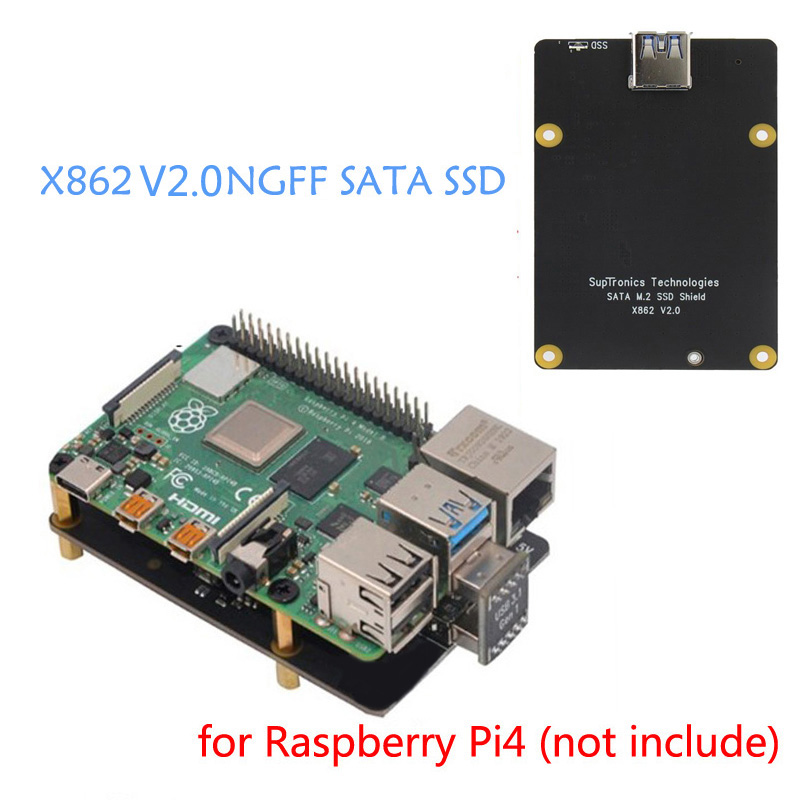- sales/support
Google Chat: zj734465502@gmail.com
- sales
+86-0755-88291180
- sales01
sales@spotpear.com
- sales02
dragon_manager@163.com
- support
tech-support@spotpear.com
- CEO-Complaints
zhoujie@spotpear.com
- sales/support
WhatsApp:13246739196
Raspberry Pi X862 M.2 NGFF SATA SSD User Guide
Overview
This is the X862 M.2 NGFF SATA SSD Shield for Raspberry Pi 4 model B, it provides a complete storage solution for raspberry pi 4. It supports multiple M.2 NGFF SSD lengths including: 2280, 2260, 2242, 2230.
Important NOTE:
This X862 is not fit to ROCK64 and Raspberry Pi 3B+ /3B because the difference of USB 3 position. Please refer to X860 if you want use M.2 NGFF SATA SSD on the Raspberry Pi 3B+/3B or ROCK64 board.
Features
| FOR USE WITH | Raspberry Pi 4 Model B |
| Operating System | All Raspberry Pi operating systems |
| KEY FEATURES |
|
| SPECIFICATION |
|
| NOTES |
|
How to Power
TAG:
ESP32 MLX90640
ESP32 S3 Development Board 1.75 inch AMOLED Display TouchScreen SD slot 6-axis sensor Xiaozhi AI Deepseek
EPS32S3 1.8inch Round LCD Display WIFI-AIDA64-Secondary-TouchScreen/Wireless-Power/Video-Player LVGL
Milk-V Duo S WIFI Configuration
ESP32 C6 Development Board 1.47 inch LCD Touch Screen 1.47inch Display 172×320SD AXS5106L JD9853
LuckFox Pico max
Raspberry Pi 5 8mp Camera
Raspberry Pi 1.54inch OLED
Raspberry Pi WatchDog
Jetson
Raspberry Pi 7 inch DSI MIPI LCD TouchScreen Display 7inch 720x1280 For Luckfox Lyra RK3506/ESP32-P4/Luckfox Omni3576
Raspberry Pi 3 display HAT
7.5 inch Passive NFC e-Paper BW Display 7.5inch E-ink Screen No Need Battery Wireless Powered Data Transfer
PCB800099
Raspberry Pi 5 Fan
0.85inch LCD
Milk-V
Windows Environment User Guide
ESP32-S3 GC9A01A
Pi 5 PCIe to M.2
TAG:
Raspberry Pi 5 DSI display
Core3566102000
Raspberry Pi5 PCIe Gigabit ETH USB3.2 HAT+
Raspberry Pi 5 - 4GB RAM
Raspberry Pi Pico 2 RP2350 1.43 inch AMOLED TouchScreen Development Board 466x466 1.43inch Display QMI8658 6-Axis | PCF85063 RTC | SD | Battery Port
E-Paper
Arduino UNO R4
Sipeed NanoKVM Cube KVM Remote OS Control Manager Power Control Desktop Server UART
LuckFox Pico
ESP32 0.85inch LCD
UART To CAN Mini
TOF Laser Range Sensor Mini Radar Arduino Raspberry Pi ESP32
Pi5 PCIe
Jetson Orin Case
ESP32 Mini TV
LCD Screen
Raspberry Pi Pico 2 RP2350 2 inch LCD Capacitive TouchScreen Development Board 240x320 Display QMI8658 6-Axis /OV5640 Camera /SD /Battery Port
X1009 Raspberry Pi 5 PCIe To 5-Port SATA3.0
Raspberry Pi Global Shutter Camera 1.6MP Sony IMX296 Monochrome
Raspberry Pi RP2040 1.14inch LCD





